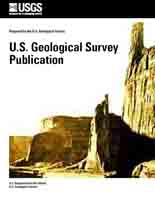 Abstract
Abstract
The Blackbird district is in east-central Idaho, about 20 miles west-southwest
of Salmon. The area is one of deeply weathered, flat-topped
upland surfaces cut by several steep-walled valleys, which are tributary
to the canyon of Panther Creek. Most of the area has a heavy vegetative
cover and outcrops are relatively scarce except in the walls of the steeper
valleys. The rocks of the district consist mostly of metamorphosed sedimentary
rocks of the pre-Cambrian Yellowjacket formation (Belt series);
a part of the Cretaceous Idaho batholith cuts across the northern part of
the district, and acid porphyry dikes and metamorphosed basic rocks cut
the Yellowjacket rocks.
Structurally, the sedimentary rocks are divided by faults into three,
roughly north-south blocks. The center one (Blackbird structural block)
appears to have been more tightly squeezed than the others into relatively
tight folds, with the development of widespread schistosity (flow cleavage).
The rocks of the two outside blocks are in more open folds. In general
they are nonschistose, except for the north end of the western block, where
there are schistose rocks cut by several north-dipping thrust faults. The
northern parts of the central and western blocks contain considerable
garnet, chloritoid, and cordierite.
The Blackbird structural block is cut by a number of mineralized shear
zones. Those dipping moderately northeast and striking northwest, and
those dipping steeply and striking north and northeast; appear to be most
important. The mineralized rock contains chalcopyrite, cobaltite, pyrite,
and pyrrhotite into a gangue of quartz, biotite, tourmaline, ankerite, and
muscovite; the deposits were formed mostly by replacement of the shear
zones. In addition, the block is cut by north-dipping thrust faults of
west to northwest strike, and a number of high-angle faults.
The district was first prospected about 1893; considerable developmont
was done at the Brown Bear mine in 1899-1902, at the Haynes-Stellite
in l917-1920, and at the Uncle Sam mine in 1938-1941, During World War
II, the U.S. Bureau of Mines explored in the district with bulldozer and
diamond drill., and the U.S. Geological Survey mapped the district and
logged the drill cores. The Howe Sound Co. also did some diamond drilling in the district, and in 1945 the Calera Mining Co., Blackbird Division
(subsidiary of Howe Sound Co.), started underground development at the
Calera adit. Although the district has had very little production to the
present, it is believed that a large tonnage of copper-cobalt ore exists
in the district which should permit mining to be continued over a long
period.
The report contains brief descriptions of all the accessible workings
in the district, of which the most important are Calera, Brown Bear,
Uncle Sam, and Hawkeye mines. In the Calera adit, about 1,700 feet of
the mineralized zone, ranging in width from 3 feet to 40 feet and averaging
about 15 feet; have been explored (August 1946); the zone lies on a wide
northwest-striking shear zone dipping moderately ( 60° ±) northeast. The
Brown Bear adit is in a wide, mineralized, north-south shear zone in which
are higher-grade pods plunging 25° to 35° north. The Uncle Sam mine explores
a relatively narrow north-south shear zone in which are two or
three north-plunging ore shoots. The Hawkeye mine is in a broad zone of
mineralized schist in which are several north-plunging lenses of ore.